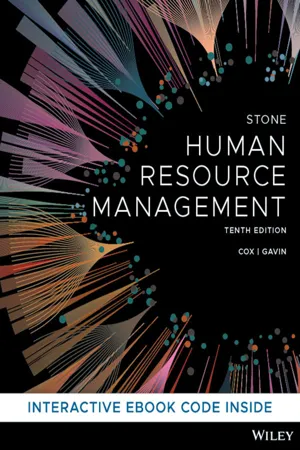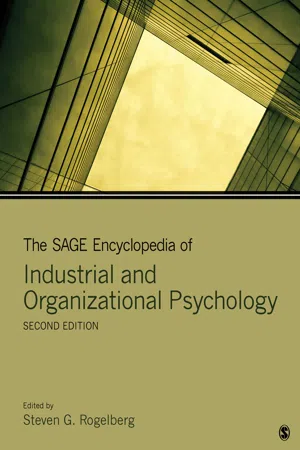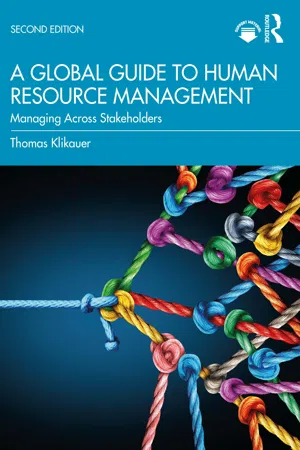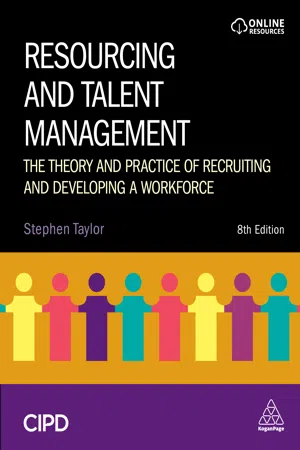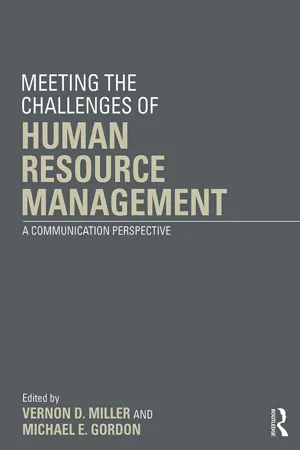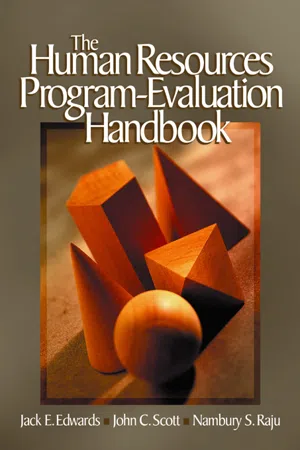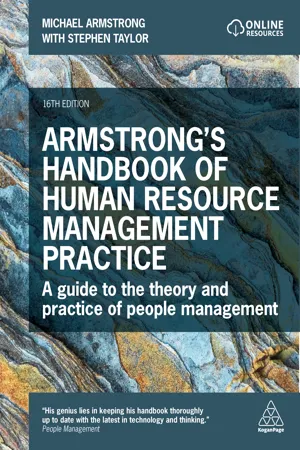Business
Methods of Recruitment
Methods of recruitment refer to the various strategies and processes used by organizations to attract and hire new employees. This can include internal methods such as employee referrals and promotions, as well as external methods like job postings, recruitment agencies, and social media advertising. Effective recruitment methods are essential for businesses to attract and retain top talent.
Written by Perlego with AI-assistance
Related key terms
Related key terms
1 of 4
Related key terms
1 of 3
8 Key excerpts on "Methods of Recruitment"
- eBook - ePub
- Raymond J. Stone, Anne Cox, Mihajla Gavin(Authors)
- 2020(Publication Date)
- Wiley(Publisher)
CHAPTER 6 Recruiting human resourcesLEARNING OBJECTIVES
After studying this chapter, you should be able to:- 6.1 describe strategic recruitment
- 6.2 discuss the major internal and external sources of human resources, the traditional recruiting methodsand their advantages and disadvantages, and e-recruiting and the use of social networking sites as recruiting tools
- 6.3 discuss the recruitment of women; people with disability; older workers; migrants; Indigenous Australians; and LGBTIQA+ workers
- 6.4 evaluate the recruitment activity.
6.1 Strategic recruitment
LEARNING OBJECTIVE 6.1 Describe strategic recruitment.The pressures of competition, cost saving, downsizing and global skill shortages have made recruitment a top priority. The scarcity of talent means that skilled workers are especially in demand in today’s competitive environment. For many companies, talented people are the prime source of competitive advantage.2Recruitment(the process of identifying,pre-screeningand attracting a pool of qualified candidates for a job vacancy) and selection (the process of choosing the candidate who best meets the selection criteria) are used today as major levers to bring about strategic and cultural change.3 An organisation must attract qualified candidates if it is to survive and grow.Leading US companies such as Microsoft have created an ‘employment brand’ to convey their values, policies, systems and culture in order to create a differentiated image in the minds of potential employees and attract top talent.4 Marketing techniques are being applied to persuade candidates to join an organisation and stay. Matthieu Imbert-Bouchard, Managing Director (Singapore) at recruitment agency Robert Half, saysemployment branding‘draws on the value and reputation of a company’s corporate brand alongside what organizations have to offer to potential and existing employees over others in their market space.’5 Providing a workplace that encourages ethical and socially responsible behaviour, for example, is seen as a differentiator that attracts the best people.6 Research similarly shows that job seekers are more likely to apply for a position within a company whose CEO is perceived as ethical.7 An organisation’s image or brand is clearly important in influencing applicant evaluations of the company and its employment opportunities.8 How companies manage their brand during times of economic crisis is also important for future recruitment. For example, the COVID-19 pandemic caused financial struggles for many organisations globally. Short-term cost-cutting measures can result in longer term reputational damage.9 - Steven G. Rogelberg(Author)
- 2016(Publication Date)
- SAGE Publications, Inc(Publisher)
Effective recruitment that supports business strategy execution is essential to organizational success. In recent years, scholarly research and the business press have documented the importance of human capital to organizational performance. Effective recruiting is a foundation of both strategic human resource management systems and strategic execution. Because strategic execution relies on employees to transform a strategy from an idea into real services, products, markets, technologies, and prices, firms must hire people who fit the culture and have the right mix of competencies to generate sustainable competitive advantage. However, if high-potential employees are not effectively recruited, they will never apply and can never be hired. Research suggests that recruitment can have significant impact on applicant quality and the talent pool, which in turn can lead to a significant productivity advantage for the hiring organization.Recruitment has important implications for individual job seekers as well. The hiring process is a two-way street: Employers attempt to attract qualified employees, and individuals attempt to find satisfying work. Ideally, recruitment leads individuals to make job choices that meet their personal needs and maximize person–job and person–organizational fit.Recruitment is a process that unfolds over time. It comprises three phases. First, the organization must generate applicants. It must identify a pool of potential employees and persuade a reasonable number of individuals in that pool to apply for work in the organization. Second, it must maintain applicant interest as the candidates proceed through the organization’s (sometimes lengthy) screening processes. Finally, the organization must persuade the most desirable applicants to accept job offers.Recruitment outcomes also unfold over time. In the short run, organizations might assess what are known as prehire outcomes, such as the quantity, quality, and diversity of applicants or the length of time required to fill a position. In the longer term, organizations might assess long-term or posthire outcomes- eBook - ePub
A Global Guide to Human Resource Management
Managing Across Stakeholders
- Thomas Klikauer(Author)
- 2022(Publication Date)
- Routledge(Publisher)
2 Getting the Right People Recruitment and SelectionDOI: 10.4324/9781003293637-2Executive Summary
Recruitment and selection is the process through which companies hire people. It is divided into two parts: (1) recruitment that establishes a pool of suitable candidates and (2) selection which is the process of selecting the right candidate from this pool. The pool of candidates should have the right number of people with the right skills who are likely to accept the position. Recruitment and selection should be underscored by a formal HR policy. This demands that recruiters engage with the labour market that is different from, for example, the commodity market. Recruiters use different strategies to advertise positions while looking for a few basic overall characteristics in future employees. The selection process starts when recruiters establish a short list of candidates and conduct interviews which are followed by reference checking and additional testing. Once this is completed, HR recruiters can offer the position to the potential candidates. The recruitment and selection process ends when a position is offered and accepted and the candidate participates in an induction programme.Key Learning Objectives
- Realise the importance of recruiting talent for business success;
- Identify the difference between “recruitment” and “selection”;
- Outline the recruitment strategies a company can use to fill job vacancies;
- Describe the key elements of the recruitment and selection process;
- Explain the role of recruiters in the recruitment process;
- Understand the preferred methods used in selecting human resources;
- Show an awareness of how culture can influence the recruitment process;
- Ascertain key fallacies in recruiting and selecting; and
- Develop a formal HR policy on recruitment and selection.
Recruitment
For most people, working life starts with being recruited to work for a company, a firm, or a corporation. At its most basic level, a company is an organisational structure set up as a legal entity for the economic purpose of achieving profit maximisation. At a larger level, corporations are owned and controlled by shareholders and each of their shares creates ownership in the corporation.1 Control over a corporation and its profits is determined by the portion of shares owned in the company. One of the crucial legal decisions on corporations came with “Dodge vs. Ford Motor Company”2 - eBook - ePub
Strategic People Management and Development
Theory and Practice
- Gary Rees, Ray French, Gary Rees, Raymond French(Authors)
- 2022(Publication Date)
- CIPD - Kogan Page(Publisher)
Recruitment and selection are often presented as a planned rational activity, comprising certain sequentially linked phases within a process of employee resourcing, which itself may be located within a wider HR management strategy. The two terms are commonly differentiated although there is a clear link between them.Recruitment is commonly understood as a process by which a pool of capable people is generated, who then apply for employment in an organisation. Selection is the process by which managers and others identify and use valid instruments enabling them to choose potentially effective future employees from a pool of applicants. When selecting employees, those responsible will need to act in the light of given management goals within the organisation and, of course, the legal requirements in place within a specific country and any relevant pan-national institutions.Recruitment and selection are interlinked; however, each element can require specific skills and expertise, and may therefore be best carried out by different people. It is not uncommon for the recruitment activity – although not normally the selection decision itself – to be outsourced, for example, to an agency. It is useful to treat each activity separately (see also Hook and Jenkins, 2019).Recruitment and selection, as defined here, can play a pivotally important role in shaping an organisation’s effectiveness and performance, if work organisations are able to acquire workers who already possess relevant knowledge, skills and aptitudes and can make an accurate prediction regarding their future abilities. If we accept this premise (which will be questioned to some extent in this chapter), then recruiting and selecting staff in an effective manner can both avoid undesirable costs – for example, those associated with high staff turnover, poor performance and dissatisfied customers – and engender a mutually beneficial employment relationship characterised, wherever possible, by high commitment on both sides.Recruitment and selection is a topical area. While it has always had the capacity to form a key part of the process of managing people as a routine part of organisational life, it is suggested here that recruitment and selection has become ever more important as organisations increasingly regard their workforce as a source of competitive advantage. Of course, not all employers engage with this proposition even at the rhetorical level. However, there is evidence of heightened interest in the utilisation of employee selection methods which are valid, reliable and fair. For example, the search for rigorous application and scrutiny of employee selection procedures has seen insights derived from work psychology have increasingly significant influence on the way people are recruited into work roles. (Arnold et al, 2020). In this chapter we will examine several contemporary themes in recruitment and selection including the so-called competency approach and online recruitment. - eBook - ePub
Resourcing and Talent Management
The Theory and Practice of Recruiting and Developing a Workforce
- Stephen Taylor(Author)
- 2021(Publication Date)
- CIPD - Kogan Page(Publisher)
05Recruitment advertising
LEARNING OUTCOMES By the end of this chapter, readers should be able to:- distinguish between recruitment strategies based on internal and external sources
- draft advertisements for filling vacancies and select appropriate media for specific cases
- evaluate advertising media and other Methods of Recruitment
- advise organisations on the options for e-recruitment.
- the cases for and against internal and external recruitment
- different recruitment advertising strategies
- the growth, advantages and disadvantages of using social media in recruitment.
Introducing recruitment
The terms ‘recruitment’ and ‘selection’ are often considered together, but they are in fact distinct human resource management activities. While recruitment involves actively soliciting applications from potential employees, selection techniques are used to decide which of the applicants is best suited to fill the vacancy in question. We can thus characterise recruitment as a positive activity requiring employers to sell themselves in the relevant labour markets so as to maximise the pool of well-qualified candidates from which future employees can be chosen. By contrast, selection can be seen as a negative activity in so far as it involves picking out the best of the bunch and turning down the rest.That said, it is equally important to understand that there is a recruitment side to selection and a selection side to recruitment. For example, there is considerable published evidence which demonstrates how heavily influenced job applicants are by the way they are treated during the selection process (Lievens and Chapman, 2020: 129). Many make direct inferences about what life would be like working for an organisation on the basis of how its recruiters treat them and the perceived fairness of selection methods used. If they are unimpressed, they tend to turn down job offers and also pass on these negative impressions to colleagues. - eBook - ePub
Meeting the Challenge of Human Resource Management
A Communication Perspective
- Vernon D. Miller, Michael E. Gordon(Authors)
- 2014(Publication Date)
- Routledge(Publisher)
PART II StaffingPassage contains an image
3 Employee Recruitment
James BreaughDOI: 10.4324/9780203097984-5Regardless of the type of organization, an employer’s success is dependent upon the quality of its workforce. Because the manner in which an employer recruits affects the type of individuals it hires, it is not surprising that the topic of employee recruitment has received substantial attention from researchers (see Dineen & Soltis, 2011 , for a review of this research) and practitioners (see Breaugh, 2009, for examples of innovative recruitment practices used by employers). In this chapter, I focus on recruitment as a communication process between an organization with job openings to fill and individuals who may be interested in applying for them.1At the outset, two issues should be noted. First, given the breadth of the recruitment literature, choices had to be made in terms of what topics to cover. This chapter focuses on external recruitment defined as such:an employer’s actions that are intended to (1) bring a job opening to the attention of potential job candidates who do not currently work for the organization, (2) influence whether these individuals apply for the opening, (3) affect whether they maintain interest in the position until a job offer is extended, and (4) influence whether a job offer is accepted. (Breaugh, 2008, pp. 103–104)Second, although emphasis is placed on an organization as the sender of a recruitment-related message, the perspective of a job applicant as the message recipient is also addressed because applicant-related variables influence the effectiveness of recruitment communications.The Perspective of a Job Applicant
Research (e.g., Uggerslev, Fassina, & Kraichy, 2012) has established that whether a person applies for a job (and ultimately whether a job offer is accepted) is strongly related to its perceived attractiveness. Among the job and organizational attributes that determine the attractiveness of a position are the tasks involved, pay, benefits, coworkers, supervision, location, autonomy, advancement opportunity, and organizational reputation. The importance of these and other attributes suggest that they should be addressed during the recruitment process. Because some attributes (e.g., tuition reimbursement) may only be important to some recruits, an employer should allow sufficient opportunity for job applicants to ask knowledgeable sources (e.g., an HR recruiter, a prospective coworker) questions about job attributes. An individual’s expectancy of receiving a job offer also has been linked to a position’s attractiveness. Specifically, studies have shown that individuals often downgrade an advertised position if they perceive they are unlikely to receive a job offer (Uggerslev et al., 2012 - eBook - ePub
- Jack Edwards, John C Scott, Nambury S. Raju(Authors)
- 2003(Publication Date)
- SAGE Publications, Inc(Publisher)
This chapter is divided into three major sections. First, we provide a basic overview of the major recruitment steps and review research on reasons that applicants choose to apply for and accept jobs. Next, we discuss recruitment sources—both traditional and Internet-based approaches. Finally, we discuss four types of recruitment evaluation measures and their pitfalls.Figure 4.1 Model of Recruitment ProcessUnderstanding the Recruitment Process
We define recruitment as organizational practices and policies developed for the primary purpose of motivating applicants to apply, remain in the candidate pool, and accept job offers. In keeping with this definition, and for the purpose of helping to understand the recruitment process, we depict the basic steps in a recruitment process in Figure 4.1 . As shown in Figure 4.1 , we assume that the recruitment process begins with a signal or announcement by the organization of a job opening, which in turn produces job applicants (Step 2). The third step involves an exchange of information between the organization and the applicants. In this step, the organization may obtain further information from applicants (e.g., what is traditionally referred to as the selection process), and applicants may obtain more information from the organization (e.g., ask about the nature of the job and visit the organization’s plants or facilities). Offers for employment are made by the organization in the fourth step of the process and either accepted or declined by the applicants in the fifth step of the recruitment process.Even though applicants may fail to apply to as many as one third of the job openings they review (Barber & Roehling, 1993), there has been little research on the reasons applicants choose to apply for some jobs but not others. To simplify this discussion, we divide the research into two approaches: The research that focuses on the factors that people consider in choosing to apply for jobs and accept offers, and the research that addresses the process - eBook - ePub
Armstrong's Handbook of Human Resource Management Practice
A Guide to the Theory and Practice of People Management
- Michael Armstrong, Stephen Taylor(Authors)
- 2023(Publication Date)
- Kogan Page(Publisher)
27Recruitment and selection
Introduction
This chapter starts with an overview of the recruitment and selection process and of how it is planned and progressed. It then deals in turn with:- Defining requirements
- Attracting applicants
- Sourcing candidates: digital and traditional approaches
- Screening applications
- Selection methods
- Interviewing
- Testing
- Assessment centres
- Assessing candidates
- Completing the process
The recruitment and selection process
Recruitment is the process of finding and engaging the people the organization needs. Selection is that part of the recruitment process concerned with deciding which applicants or candidates should be appointed to jobs.The aim of recruitment and selection is to find suitable candidates to fill vacancies and then predict the extent to which they will be able to carry out a role successfully. It involves deciding on the degree to which the characteristics of applicants in terms of their competencies, experience, qualifications, education and training match a person specification.It is not easy to get it right. According to Groysberg et al (2009), usually about a third of promising new hires leave within three years of being recruited. And it can be costly, especially for senior staff. The 2020 CIPD survey of resourcing and talent planning found that the average recruitment cost of filling a vacancy for a director or senior manager was £5,000, while for other employees it was £2,000.Recruitment and selection programmes can be complex and careful planning is necessary. There is always a choice between different sources of candidates, the use of digital or other technologies rather than traditional methods, the use of interviews, tests or assessment centres, and the type of interview (face-to-face, telephone or video) and the type of test.The process may start with a workforce plan from which detailed recruitment plans are derived. But requirements more commonly emerge on an ad hoc basis because of the creation of new posts, expansion into new activities or areas, or the need for a replacement. These short-term demands often put HR under pressure to deliver candidates quickly.
Index pages curate the most relevant extracts from our library of academic textbooks. They’ve been created using an in-house natural language model (NLM), each adding context and meaning to key research topics.
Explore more topic indexes
Explore more topic indexes
1 of 6
Explore more topic indexes
1 of 4
